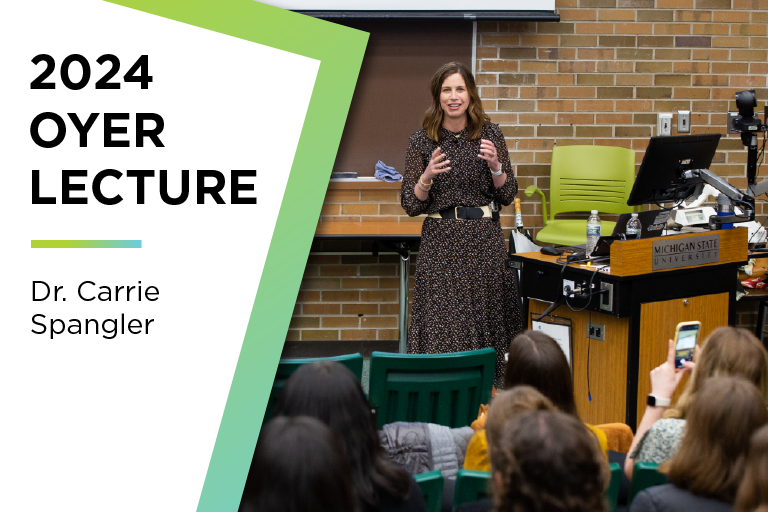On March 8, the Department of Communicative Sciences and Disorders hosted the 2024 Oyer Lecture on campus and online. The event is named for Dr. Herbert J. and Dr. E. Jane Oyer. Herbert J. Oyer came to Michigan State University in 1960 as director of the Speech and Hearing Clinic.
This year’s speaker was Dr. Carrie Spangler, educational audiologist in Ohio and owner of empowEAR Audiology and Coaching, an organization supporting people who are deaf or hard of hearing, their families, educators and audiology speech language pathology professionals.
Speaking with the aid of an American Sign Language (ASL) interpreter, Spangler described the collaboration between educational audiologists and speech language pathologists (SLP) as they serve children who are deaf or hard of hearing.
“If you end up working in the schools or a pediatrics type of setting, you will likely run into a student sometime in your career that is hard of hearing,” Spangler said. “How do you collaborate with the right people? I want you to be thinking about some of the things that could negatively impact the students in a school setting and how we make sure the classroom is accessible for them.”
Spangler referred to educational audiologists as “brain builders” for young children, noting that the brain’s auditory functions are not fully developed until about age 15.
“So, every single student is probably at risk of not hearing appropriately in the classroom,” she said. “About 60 to 70 percent of what we expect kids to learn is through listening in the classroom, and that doesn’t even factor in all of the visual information that they’re trying to take in and multitasking throughout the class.”
Spangler noted that the elementary classroom of today isn’t designed like those of previous generations. When she was growing up, Spangler said, students sat in rows of desks with the teacher standing at the front of the room. She said, growing up with a hearing loss herself, she learned how to position herself where she knew the teacher would be standing so she could better hear and understand what was being said.
“But when I go into the classroom now, we have a lot of different learning styles,” Spangler said. “When we think about our hard of hearing kids, the environment is changing all the time. Kids are moving their seats. They’re bouncing on balls. They’re standing up at high tables…there’s lots of movement happening within the classroom. When you’re thinking about deaf and hard of hearing kids, sometimes that can be a big factor.”
Spangler also said it’s vital that parents, teachers and anyone else in the education continuum help hearing impaired students learn to advocate for their own needs.
“One of the things that I wish I would have had more of growing up was advocacy and being more determined about who I was; to be able to make decisions that were important for me and that were autonomous (to) me,” Spangler said. “Without having knowledge of what your difference or disability or however you want to frame it is, it’s really hard to advocate. It’s important to be able to teach a student from a young age how to advocate for their hearing needs all the way through high school and beyond.”
By: Kevin Lavery
